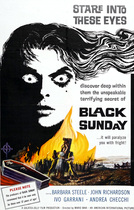Our editor-in-chief Nate Yapp is proud to have contributed to the new book Hidden Horror: A Celebration of 101 Underrated and Overlooked Fright Flicks, edited by Aaron Christensen. Another contributors include Anthony Timpone, B.J. Colangelo, Dave Alexander, Classic-Horror.com's own Robert C. Ring and John W. Bowen. Pick up a copy today from Amazon.com!
The Disused Fane: Go Into the Light
One of the best parts (there are many) from the Spanish flick Horror Rises from the Tomb (1973) is an early scene in which the protagonists, all of whom are bored rich people, attend a séance. They want to get in touch with their ancestors; it's not like they have anything better to do with their time. They succeed. Unfortunately for them, the film already opened with a prologue set in the Middle Ages in which a certain nobleman and his mistress are executed for practicing witchcraft. Naturally, it is these two individuals who manifest themselves at the séance, and naturally, this inspires the one guy to take everyone up to the old ancestral castle to start digging for things in the crypts. It doesn't turn out well.
Many of us do wonder, though, where we came from, and if any of those voices from the past might still be heard. We live in an age in which one is lucky to get 15 minutes of fame. Longer than that is "history", and nobody cares about history. The dead are of no real interest to anyone but the immediate family and friends of the deceased. But what if the dead could help us? What might they have learned since their death? What do they think of us, now?
Spiritualism was a loosely-organized religious movement that attempted to address these questions. It was most popular in Britain and North America in the 19th and early 20th Centuries - the period when attendance at séances, as well as spirit photography and other paranormal hobbies, were at their most popular. Spiritualists, taking their cues from Christian mysticism (and also from early animism and shamanism) believed that the soul not only lived on after death, but continued to learn and develop, and could even share its new insights with the living. Thus Spiritualists tried to communicate with the departed through persons gifted with the ability to perceive and speak with the dead, known as mediums. Different Spiritualist factions took different approaches. The séance was the most dramatic approach, particularly since it was often faked or embellished. The idea of the séance, and the character of the medium, have continued to pique our interest, in film and elsewhere - both tend to make regular appearances wherever there's a haunting to be found on celluloid. Especially a haunting in which the spirits are not interested in helping the living.
Poltergeist (1982) gives us perhaps the most memorable medium in cinema: Tangina Barrons, played by Zelda Rubinstein, who arrives at the Freeling house to "clear" it after 5-year-old Carol Anne is pulled into the spirit world by an amalgamation of ghosts. The flamboyant and intuitive Tangina succeeds (mostly...) where the more cautious and rational paranormal investigator Dr. Lesh could not, as Tangina is able to speak to the dead directly. She underestimates the resolve of the evil presence in the house, however, and the Freeling family's contact with the spirit world soon becomes even more nightmarish. These ghosts have not progressed in the afterlife, but have gotten stuck somewhere along the way, and are being manipulated by a malevolent force with a vendetta against the entire neighborhood.
In The Haunting (1963), Dr. Markway's attempt to investigate Hill House leads him to recruit only people who have some association with psychic phenomena, notably the clairvoyant Theo and the neurotic Eleanor. Markway displays an almost childlike excitement when he talks about discovering something new and different - legitimate proof of the supernatural. To him, the nights spent in Hill House are an adventure. But for Eleanor, to whom the house seems to call, it ends in tragedy. Where Markway would seek a bold way forward, the house's dark past stands in his way.
More recent films have not neglected the use of the medium and the séance. Drag Me to Hell (2009) features a particularly cool séance sequence in which, prior to a mostly-bungled attempt to exorcise the demon stalking the heroine, the medium San Dena conjures up and dismisses a host of spirits from various times. Paranormal Activity (2007) gave us the ineffectual Dr. Fredrichs, who does at least inform the protagonists that they are dealing with a demon rather than a ghost. The demon is specifically interested in Katie, and has been throughout her life, and not because it wants to give her advice.
Where movies are concerned, there wouldn't be much horror if contact with the dead produced nothing but insight, progress, and serenity. In the blasé socialites of Horror Rises from the Tomb, the stable middle-class family of Poltergeist, and the idealistic researcher of The Haunting, we see people who are adrift in the present, and trying to open the way to the future by delving into the past. Contrary to what Spiritualism would have envisioned, the spirits they encounter do not lead them forward, but drag them back. They seem to suggest that the only spirits who can spare the time to interact with the living are those still trapped by long-ago mistakes and longstanding pain. The rest have moved on, into the light Tangina was fond of raving about, and can teach us, perhaps, only by example.








